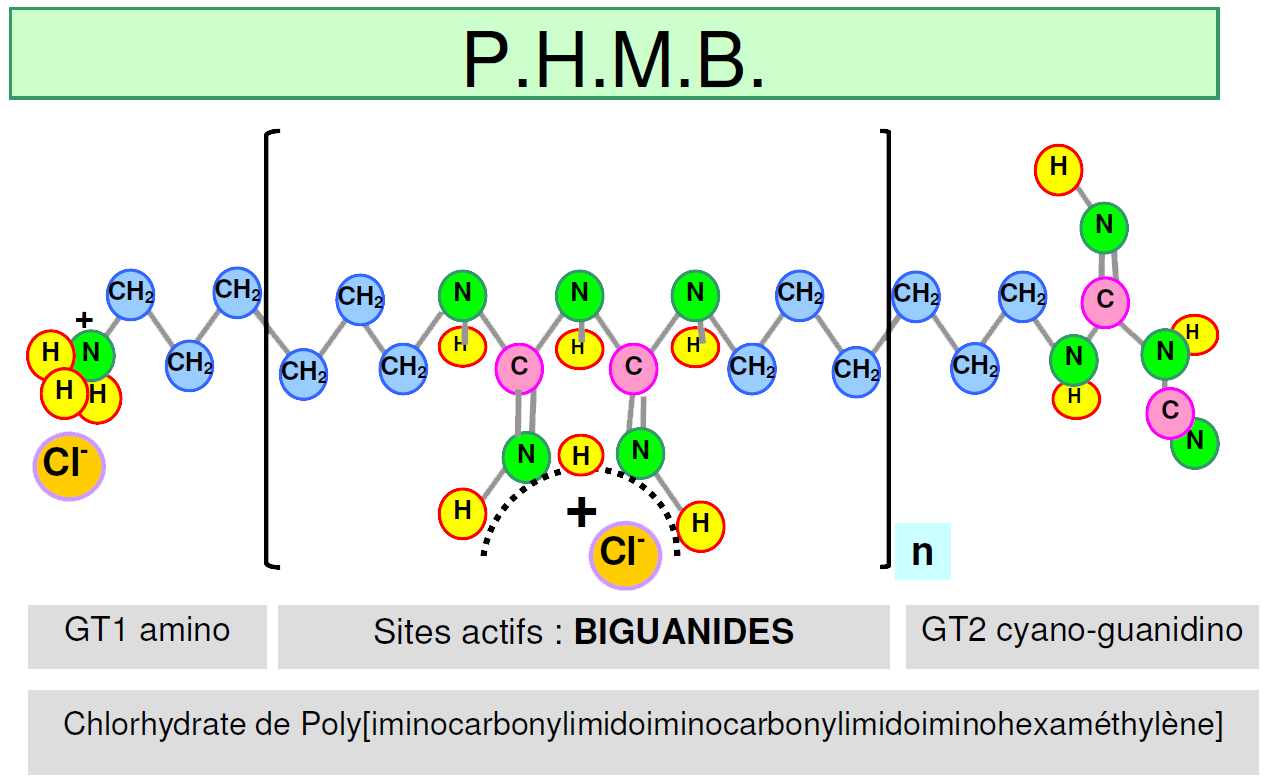Chemical overview
Laboratoire PAREVA – leading manufacturer of bulk Biguanide
What is biguanide?
PHMB stands for PolyHexaMethylene Biguanide. PHMB 20% solution can be used in its hydrochloride form. Its chemical formula can be illustrated as follows:

Biguanide groups are the active parts of the PHMB.
Compared to other Biguanide compounds, PHMB polymers contain alternating chains of biguanide units and C6 aliphatic hydrocarbon chains, making it a particularly effective solution for eliminating a wide range of microorganisms.
Its hydrochloric form implies that PHMB has cationic properties or positively charged ions.
PHMB is not a Quaternary Ammonium Compound (QAC). However, it can be a solution for synergetic disinfection when blended with QACs.
PHMB identification
PHMB CAS Registry Number
PHMB can be identified by several CAS (Chemical Abstracts Service) registry numbers (CAS n. 133029-32-0 / CAS n.32289-58-0 / CAS n.1802181-67-4 / CAS n. 91403-50-8 / CAS n. 27083-27-8).
While PHMB was initially registered under CAS 91403-50-8 in European Union. Today, the number assigned to our chemical substance is CAS 32289-58-0 and 1802181-67-4.
Furthermore, the CAS name for the identification number 32289-58-0 can be read Poly(iminocarbonimidoyliminocarbonimidoylimino-1,6-hexanediyl), hydrochloride
International Name for Cosmetic Ingredients (INCI)
PHMB INCI name is PolyAminoPropyl Biguanide (PAPB) and is registered under the following two CAS numbers [133029-32-0] or [32289-58-0]
Laboratoire Pareva’s corresponding cosmetic grade is “PHMB P20 PC” (Personal Care grade).
International Non-proprietary Name (INN, or Generic Name)
INN (or generic name) facilitates the identification of pharmaceutical substances or active pharmaceutical ingredients (APIs). Such a unique name is intended for use in pharmacopoeias, and namely product information labels.
PHMB INN is listed in pharmaceutical preparations as Polyhexanide.
How Biguanide works in the PolyHexaMethylene (PHMB) Biguanide compound:
Below you will find a five-step simplified description of the biguanides mechanism of actions against bacteria:
- Because of its cationic properties, PHMB is attracted and actively binds to surface bacteria
- PHMB neutralises the cell wall protection system as it combines with proteins
- PHMB passes through the cell wall to join the cytoplasmic membrane
- PHMB initiates its first stage of action against bacteria as it creates space in the cytoplasmic membrane by associating with proteins. Consequently, small compounds such as potassium, calcium are discharged and as a result, the bacteria membrane become permeable.
- PHMB starts its second stage of action against bacteria as it breaks up the cytoplasmic membrane of the cell. The cell loses its vital compounds (proteins and other high molecular weight compounds), destroying the cell completely.
Some efficacy data
This data is provided as a guideline for public use. To ensure accuracy it is recommended that customers perform their own tests to ensure efficacy.
Micro-organisms | Indicative M.I.C. values (ppm) |
Bacteria Pseudomonas aeruginosa (G-) Proteus Hauseri (G-) Salmonella Enterica (G-) Klebsiella aerogenes (G-) Escherichia coli (G-) | 75 (*) 75 64 25 16 |
Yeasts | Indicative M.I.C. values (ppm) |
Candida albicans | ≤ 50 |
Fungii | Indicative M.I.C. values (ppm) |
Aspergillus Brasillensis (ex-niger) | ≤ 500 |
Further Data Available :
EN 1276, EN 13727, EN 1656, EN 1650, EN 13697, EN 14349, EN 1499.

High Quality

available team

efficient and reactive logistics

high storage capacity

competitive prices

Quality certification
Laboratoire PAREVA is an ISO 9001/2015 accredited company. Our Quality Management system ensures that customers receive consistent and high-quality products and services.
If you require additional information, please contact Daniel at msds@pareva.fr.
